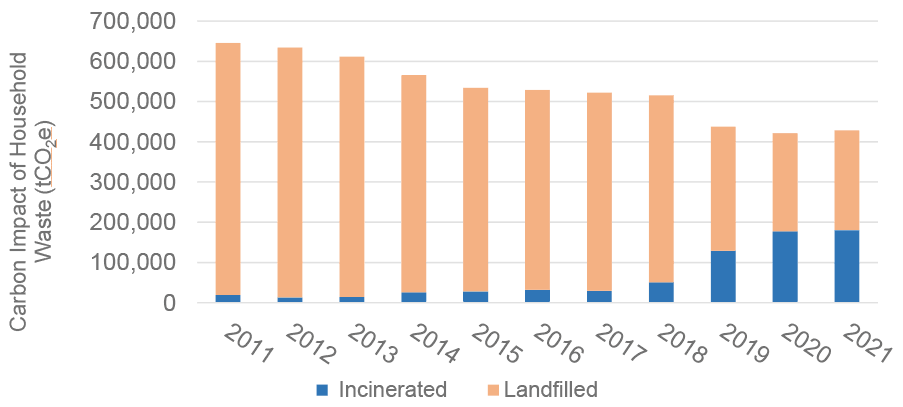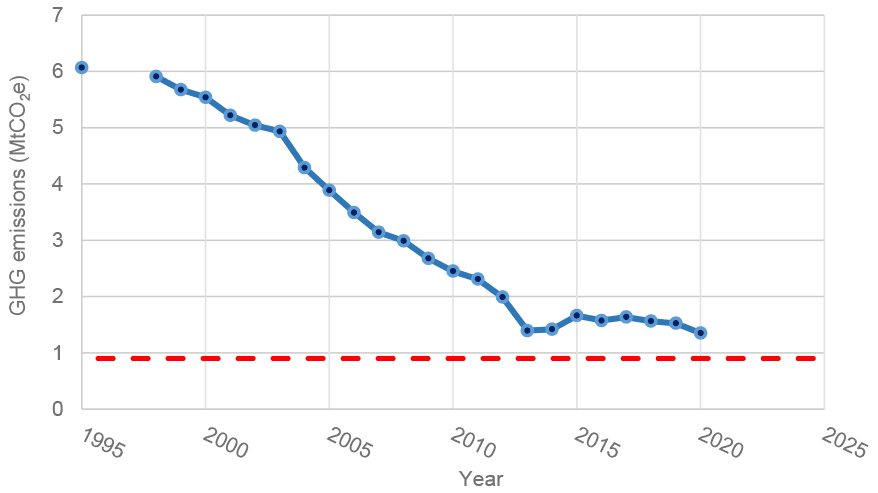Decarbonisation of residual waste infrastructure: report
Second report and supporting documents from the Independent Review of the Role of Incineration in the Waste Hierarchy in Scotland (Stop, Sort, Burn, Bury?), on decarbonisation of residual waste infrastructure in Scotland.
3 Greenhouse Gas Emissions from Residual Waste Management
What does the current carbon impact of disposal of waste look like?
3.1 Residual Waste Management in Scotland
As previously noted[11], Scotland produced around 11.5 million tonnes (Mt) of waste in 2018 from households (HH, 2.4Mt), Commercial & Industrial sources (C&I, 3.2Mt) and Construction & Demolition activities (C&D, 5.8Mt). Waste generated in Scotland has reduced by 4.2% since 2011. While there has been a general reduction in household (7% between 2011 and 2018) and C&I waste (22% between 2011 and 2018), the amount of C&D waste generated fluctuates year on year[12].
The majority of waste generated in Scotland is recycled. In 2018, 60.7% of waste from all sources was recycled. For HH waste specifically, 42.7% of waste was recycled in 2021 [13]. Residual waste is waste that is not collected for reuse or recycling, or that is rejected from those processes. This is often called ‘black bag’ waste since it includes the mixed materials generally collected in black bags or bins. Black bag waste often contains recyclable material; evidence suggests that just under 60% of material in black bags is recyclable[14]. However, material in black bag waste is often not recycled since mixing materials reduces their quality, and separation and cleaning is often not economically viable under the current market conditions.
The waste hierarchy gives preference, after reuse and then recycling, to recovering value from residual waste (for example through incineration with energy recovery) with disposal (for example in landfill) being the least preferable option. The total quantity of waste incinerated in Scotland in 2021 was 1.35Mt, 612kt of which was HH waste13, an increase of 0.93Mt (7.4%) from 2020, consistent with the longer-term trend of an increase of 0.94Mt (230%) from 2011[15]. The amount of waste disposed of to landfill has generally decreased steadily since 2007. In 2020, Scotland sent 2.6Mt to landfill, a reduction of over 4.4Mt (63%) since 20051, similarly, the amount of household waste sent to landfill decreased by 54.4% between 2011 and 2021 when 664kt was sent to landfill13. From 31 December 2025, biodegradable municipal waste in Scotland will be banned from landfill[16] (‘the Ban’).
With waste policy generally diverting waste away from landfill (especially through application of the Scottish landfill tax and the forthcoming Ban), the number of landfill sites in Scotland has decreased. In 2005 Scotland landfilled over 7Mt of waste at 129 active landfill sites compared to 2.6Mt at 41 sites in 2020 [17].
Scotland currently has 6 operational municipal waste incinerators. There are two main technologies employed in Scotland: mass burn and gasification (a type of advanced thermal technology, ATT). Scotland also has several pre-treatment facilities, although some may operate only as mechanical sorting facilities while some will undertake biological treatment, such as composting or anaerobic digestion. All of these methods of managing residual waste emit greenhouse gases (GHGs) in different orders of magnitude.
3.2 Greenhouse Gas Emissions from Residual Waste Management
The main GHGs of concern in waste management are carbon dioxide (CO2) and methane (CH4). Carbon dioxide is emitted when a material containing carbon is burned in the presence of oxygen, for example in a waste incinerator. Methane is emitted when biodegradable material[18] decomposes in a landfill in the absence of oxygen[19]. Estimates of the proportion of HH waste that is made up of biodegradable material vary, but most suggest it is at least half, if not more. GHG emissions are generally reported in terms of “tonnes of carbon dioxide equivalent”, abbreviated to “tCO2e”. Methane is approximately 25 times more potent a GHG than carbon dioxide[20], which means that a tonne of the former will equate to ~25tCO2e. These factors together help explain why Scotland is moving its residual waste treatment away from landfill and towards incineration – each amount of biodegradable waste that is incinerated rather than landfilled will reduce total GHG emissions significantly.
The Scottish Government’s Climate Change Plan sets out a target of reducing emissions by 75% by 2030 and finally to net zero by 2045 [21]. The Climate Change Plan sets out target ‘emissions envelopes’ that each sector will need to reach to achieve Net Zero. Table 1 illustrates the main sources of GHG emissions for Scotland’s residual waste management infrastructure in 2021.
| Source | CO2 emitted (tonnes) | CH4 emitted (tonnes) | CO2 equivalent (tonnes)[23] |
|---|---|---|---|
| Landfill | 324,664 | 19,772 | 817,714 |
| Energy from Waste | 660,618 | Below reporting threshold | 660,618 |
Figure 2 shows the carbon impact[24] of HH waste landfilled and incinerated between 2011 and 2021. While the overall emissions from HH waste disposed of by landfill and incineration has decreased, the relative carbon impact from incineration has increased, particularly since 2017.

Emissions from and therefore the carbon impact of waste sent to landfill are expected to continue to decline as Scotland moves towards the Ban and as incineration capacity increases with more facilities coming online[26]. However, this is likely to lead to further increases in the carbon impact of HH waste incinerated. While this should result in a continued net reduction in the carbon impact of HH waste treatment overall, this will very much depend on the amount of residual waste produced, and the composition of waste[27].
The Scottish Government has set out several targets and policies which could reduce greenhouse gas emissions from the Waste Management sector[28]. Since publication of Stop, Sort, Burn, Bury?, the Scottish Government has also consulted on a Route Map to 2025 and beyond, which proposes further policies, including additional policies to reduce emissions from incineration, which are summarised in Annex C – Policy Context. The UK also signed up to the Global Methane Pledge at COP26, which aims to collectively reduce global emissions by at least 30% below 2020 levels by 2030.
3.2.1 Current Inventory Approach
Currently, internationally-agreed methodology counts the methane emissions from landfill as being due to the waste sector. Waste incineration with energy recovery has its carbon dioxide emissions accounted for under energy, not waste. Only the emissions from incineration without energy recovery (eg some forms of hazardous waste incineration) count under waste. Using this approach, emissions attributed to the waste management sector largely comprise methane from landfill and have decreased from around 6 MtCO2e in 1995 to 1.4MtCO2e in 2020 (Figure 3). This is mainly due to diversion of waste away from landfill as a result of Scottish Landfill Tax and preparations for the forthcoming ban on landfilling biodegradable municipal waste. (Note that further reductions are required to achieve the Waste Sector emissions envelopes, which are 0.9 and 0.7MtCO2e for 2025 and 2032 respectively21).

Another specific aspect of the current inventory approach is how it treats GHG emissions from the incineration of “biogenic” material. Historically, the release of carbon dioxide from the ‘slow domain carbon cycle’ – fossil fuels which, although they originally came from plants and animals, have stored the carbon for tens of thousands of years – has been of concern for climate change measurements. The release of carbon dioxide from ‘fast domain carbon cycle’ – atmospheric reactions, plants, animals, oceans, etc over tens or hundreds of years – has been considered neutral.
However, especially for the resource and waste management sector, this may no longer be adequate for several reasons. Firstly, given how little time is left for humanity to reduce its GHG emissions if it is to keep climate change below 1.5°C, even emissions on a cycle of a few hundred years could become important. Secondly, Scotland has ambitious plans to reduce the amount of food waste that is treated by residual waste infrastructure. As this starts to happen, the life cycle of the biogenic waste coming to incinerators will increase as more of it is made up of textiles (~5 years) paper and card (~20 years) and wood (tens or hundreds of years) rather than food (<1 year). Finally, given the scope for incinerators to operate with carbon capture, it may become increasingly important to consider short cycle biogenic carbon.
Without consensus on how to include biogenic carbon in future modelling, it will continue to be difficult for stakeholders and policy makers to make informed decisions and recommendations for the decarbonisation of the waste sector. As an initial position, we would suggest that biogenic carbon should be included in all parts of future modelling for the resource and waste management sector. Therefore, this Second Report recommends that:
Recommendation 15: The Scottish Government should consider how biogenic carbon is included in future resource and waste management sector modelling and how this influences decision making.
This is also strongly related to the Review’s Recommendation 2[30] on the need to improve data and to understand better how the whole resource and waste management sector operates as an inter-dependent system.
3.3 Wider GHG Implications of Resource and Waste Management
Resource and waste management activities have much wider implications for GHG emissions than those traditionally captured by the current GHG accounting practices. For example, the waste management sector figures do not include emissions from incineration with energy recovery; these are reported as being emissions due to energy production. For this reason, the First Report recommended that the carbon dioxide emissions from incinerators with energy recovery should be reported separately. The CCC has made the same recommendation, and the Scottish Government has committed to do so[31].
Another ‘gap’ is that of the emissions avoided by recycling. Producing a tonne of recycled aluminium, for example, uses only 5% of the energy needed to produce the same amount of virgin aluminium[32]. However, the associated GHG savings are not recorded as being due to actions by the resource and waste management sector.
As many stakeholders have argued[33], this can lead to odd policy choices that do not reflect the true GHG emissions generated and saved through resource and waste management activities.
Contact
Email: zero_waste_inbox@gov.scot
There is a problem
Thanks for your feedback